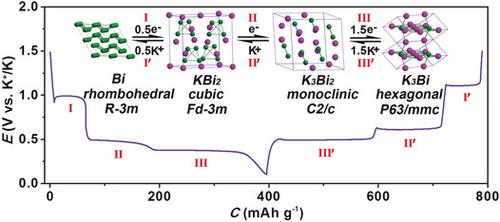当前位置:
X-MOL 学术
›
Angew. Chem. Int. Ed.
›
论文详情
Our official English website, www.x-mol.net, welcomes your
feedback! (Note: you will need to create a separate account there.)
A Porous Network of Bismuth Used as the Anode Material for High‐Energy‐Density Potassium‐Ion Batteries
Angewandte Chemie International Edition ( IF 16.1 ) Pub Date : 2018-03-15 , DOI: 10.1002/anie.201801389 Kaixiang Lei 1, 2 , Chenchen Wang 1, 2 , Luojia Liu 1, 2 , Yuwen Luo 1, 2 , Chaonan Mu 1, 2 , Fujun Li 1, 2 , Jun Chen 1, 2
Angewandte Chemie International Edition ( IF 16.1 ) Pub Date : 2018-03-15 , DOI: 10.1002/anie.201801389 Kaixiang Lei 1, 2 , Chenchen Wang 1, 2 , Luojia Liu 1, 2 , Yuwen Luo 1, 2 , Chaonan Mu 1, 2 , Fujun Li 1, 2 , Jun Chen 1, 2
Affiliation

|
Potassium‐ion batteries (KIBs) are plagued by a lack of materials for reversible accommodation of the large‐sized K+ ion. Herein we present, the Bi anode in combination with the dimethoxyethane‐(DME) based electrolyte to deliver a remarkable capacity of ca. 400 mAh g−1 and long cycle stability with three distinct two‐phase reactions of Bi↔ KBi2↔K3Bi2↔K3Bi. These are ascribed to the gradually developed three‐dimensional (3D) porous networks of Bi, which realizes fast kinetics and tolerance of its volume change during potassiation and depotassiation. The porosity is linked to the unprecedented movement of the surface Bi atoms interacting with DME molecules, as suggested by DFT calculations. A full KIB of Bi//DME‐based electrolyte//Prussian blue of K0.72Fe[Fe(CN)6] is demonstrated to present large energy density of 108.1 Wh kg−1 with average discharge voltage of 2.8 V and capacity retention of 86.5 % after 350 cycles.
中文翻译:

铋的多孔网络用作高能密度钾离子电池的负极材料
钾离子电池(KIB)由于缺乏可逆地容纳大型K +离子的材料而困扰。在此,我们介绍了Bi阳极与基于二甲氧基乙烷(DME)的电解质的组合,可提供约2,000的显着容量。为400mAh克-1并用Bi↔KBI的三个不同的两相反应长周期稳定性2 ↔K 3的Bi 2 ↔K 3双。这些归因于Bi的逐步发展的三维(3D)多孔网络,该网络实现了在钾化和去钾化期间的快速动力学和其体积变化的耐受性。DFT计算表明,孔隙率与表面Bi原子与DME分子相互作用的空前运动有关。Bi // DME基电解液//普鲁士蓝K 0.72 Fe [Fe(CN)6 ]的完整KIB被证明具有108.1 Wh kg -1的大能量密度,平均放电电压为2.8 V,容量保持为350次循环后为86.5%。
更新日期:2018-03-15
中文翻译:

铋的多孔网络用作高能密度钾离子电池的负极材料
钾离子电池(KIB)由于缺乏可逆地容纳大型K +离子的材料而困扰。在此,我们介绍了Bi阳极与基于二甲氧基乙烷(DME)的电解质的组合,可提供约2,000的显着容量。为400mAh克-1并用Bi↔KBI的三个不同的两相反应长周期稳定性2 ↔K 3的Bi 2 ↔K 3双。这些归因于Bi的逐步发展的三维(3D)多孔网络,该网络实现了在钾化和去钾化期间的快速动力学和其体积变化的耐受性。DFT计算表明,孔隙率与表面Bi原子与DME分子相互作用的空前运动有关。Bi // DME基电解液//普鲁士蓝K 0.72 Fe [Fe(CN)6 ]的完整KIB被证明具有108.1 Wh kg -1的大能量密度,平均放电电压为2.8 V,容量保持为350次循环后为86.5%。










































 京公网安备 11010802027423号
京公网安备 11010802027423号